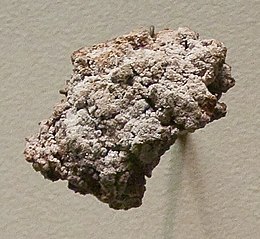Cotunnite
| Cotunnite | |
|---|---|
 Cotunnite | |
| General | |
| Category | Halide mineral |
| Formula (repeating unit) | PbCl2 |
| IMA symbol | Cot[1] |
| Strunz classification | 3.DC.85 |
| Crystal system | Orthorhombic |
| Crystal class | Dipyramidal (mmm) H-M symbol: (2/m 2/m 2/m) |
| Space group | Pnam |
| Unit cell | a = 7.6222(5) Å, b = 9.0448(7) Å, c = 4.5348(4) Å; Z = 4 |
| Identification | |
| Color | Colorless to white, pale green, pale yellow |
| Crystal habit | As elongated, flattened prismatic crystals; in aggregates of radiating sprays; granular, crustiform or pseudomorphs |
| Cleavage | Perfect on {010} |
| Fracture | Subconchoidal |
| Tenacity | Slightly sectile |
| Mohs scale hardness | 2.5 |
| Luster | Adamantine, silky to pearly |
| Diaphaneity | Transparent to opaque |
| Specific gravity | 5.80 |
| Optical properties | Biaxial (+) |
| Refractive index | nα = 2.199 nβ = 2.217 nγ = 2.260 |
| Birefringence | δ = 0.061 |
| 2V angle | Measured: 67° |
| Solubility | Slight in water |
| References | [2][3][4] |
Cotunnite is the natural mineral form of lead(II) chloride with formula PbCl2.
It was first described in 1825 from an occurrence on Mount Vesuvius, Naples Province, Campania, Italy.[3] It was named for Domenico Cotugno (Cotunnius) (1736–1822), Italian physician and Professor of Anatomy.[2]
It was first recognized in volcanic fumarole deposits. It occurs as a secondary alteration product in lead ore deposits. It has also been reported as an alteration of archaeological objects that contain lead.[2][5]
It occurs in association with galena, cerussite, anglesite and matlockite in the Caracoles, Chile. At the Tolbachik volcano on the Kamchatka Peninsula, Russia it occurs with the rare to uncommon minerals tenorite, , , , , , , halite, sylvite and native gold.[2]
References[]
- ^ Warr, L.N. (2021). "IMA–CNMNC approved mineral symbols". Mineralogical Magazine. 85 (3): 291–320. Bibcode:2021MinM...85..291W. doi:10.1180/mgm.2021.43. S2CID 235729616.
- ^ a b c d Handbook of Mineralogy
- ^ a b Mindat.org
- ^ Webmineral data
- ^ Late-Hellenistic shipwreck, Mahdia, Tunisia, (Mindat locality)
- Halide minerals
- Lead minerals
- Orthorhombic minerals
- Minerals in space group 62
- Halide mineral stubs